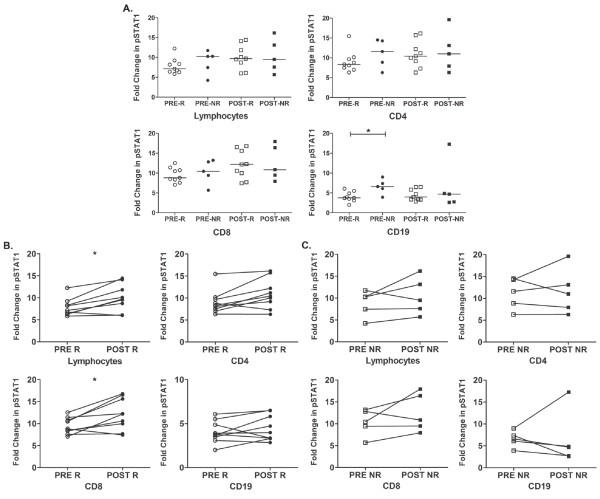Figure 1.
IFN-α induced fold change of pSTAT1-Y701 in PBMCs from responding and non-responding patients. PBMCs were stimulated with 1000 IU/ml of IFN-α or remained unstimulated and pSTAT1 was assessed by phosflow. The IFN-α induced fold change in pSTAT1 was measured in Lymphocytes, CD4 T cells, CD8 T cells and CD19 B cells. A) Unpaired analysis of PBMCs acquired before and after the 4 week induction phase with HDI were compared between responders (R: pre- open circle, post- open square) and HDI non-responders (NR: pre- closed circle, post- closed square). Two-sided Wilcoxon-Mann-Whitney unpaired analysis was used to compare between responding and non-responding lymphocytes and lymphocyte subsets. (* CD19: p = 0.028, 95% CI: 0.40 to 4.59, CV: pre-R 28.2%, pre-NR 30.9%). B) and C) Paired analysis of HDI responders (R) and HDI non-responders (NR) lymphocytes were assessed for their response to IFN-α through STAT1 activation before (pre-) and after (post-) the 4 week induction phase of HDI therapy. Two-sided Wilcoxon-Mann-Whitney paired analysis was used to compare response levels of pSTAT1 in responding and non-responding melanoma patients. The fold change was calculated by dividing the mean fluorescent intensity (MFI) of stimulated cells by the MFI of unstimulated cells. The median is indicated by the bar in each data set. Adjusted P-values < 0.05 were considered significant. CVs were calculated by dividing the standard deviation with the mean of the fold changes multiplied by 100. (* Lymphocytes: p = 0.039, 95% CI:-3.52 to -0.57, CV: pre-R 25.6%, post-R 30.1%; * CD8: p = 0.039, 95% CI: -5.0 to -0.43, CV: pre-R 19.6%, post-R 29.5%).

